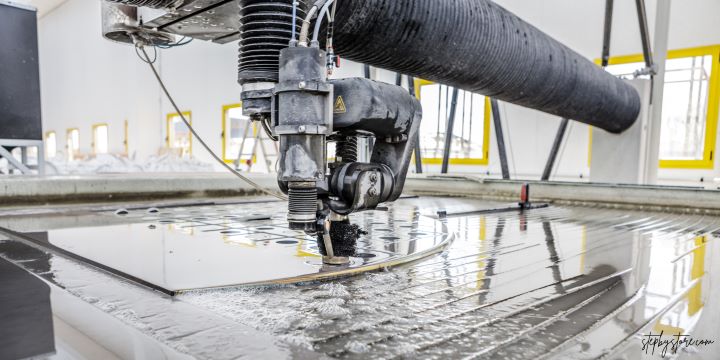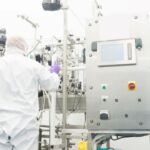Key Takeaways
- Waterjet cutting offers precision and versatility for various materials.
- This technology reduces waste and contributes to sustainable manufacturing.
- Waterjet machines have applications in several industries, including automotive, aerospace, and architecture.
Introduction to Waterjet Cutting
In the constantly changing world of modern manufacturing, it is essential to uphold efficiency and competitiveness by attaining high precision and minimizing waste. Waterjet cutting is a technology that has made a significant contribution towards achieving these objectives. Waterjet cutting, known for its precision, is now widely used in various industries due to its capability to cut through a wide range of materials. For interested individuals, purchasing a used water jet cutter for sale can be a beneficial investment in improving manufacturing capabilities without the expense of buying new equipment. The benefits it offers make it a valuable option for companies seeking to incorporate precise cutting tools.
How Does Waterjet Cutting Work?
Waterjet cutting is based on the core concept of utilizing a strong, pressurized water stream, often combined with abrasive substances, to cut and bore through various materials. This technique is capable of cutting different materials such as metals, stone, glass, and composites. Waterjet cutting is a popular choice for industries that require precise cuts because it can process a variety of materials. Waterjet cutting technology enables the creation of detailed designs and precise cuts that are difficult to achieve using traditional cutting techniques.
Abrasive vs. Pure Waterjet Cutting
Two primary categories of waterjet cutting include abrasive and pure waterjet cutting. Abrasive waterjet cutting utilizes a fine grit, usually garnet, mixed with the water jet. This added abrasive enables cutting hard materials like metals, ceramics, and stones. On the other hand, pure waterjet cutting relies solely on water and is better suited for softer materials such as rubber, paper, and foam. Each type of waterjet cutting has unique advantages, making it crucial to select the appropriate method based on the material and the desired outcome.
Advantages of Waterjet Cutting
- Precision: Waterjet machines can create intricate designs with high accuracy. This precision is precious in industries that require tight tolerances and detailed work.
- Sustainability: This method produces minimal waste, contributing to eco-friendly manufacturing processes. Unlike traditional cutting methods that generate significant waste and by-products, waterjet cutting is a more environmentally conscious choice.
- Versatility: Waterjet technology is very versatile, as it is appropriate for cutting various types of materials. Waterjet cutting can effectively handle tasks involving metal, stone, glass, or softer materials.
- Cold Cutting: Because it does not generate heat, waterjet cutting avoids creating a heat-affected zone, preserving the material’s integrity. This is particularly important for materials that could warp, melt, or change properties when exposed to high temperatures.
Applications in Different Industries
Waterjet cutting’s popularity in various industries is due to its utility and flexibility. Waterjet cutting is commonly utilized in the automotive sector for creating prototypes and manufacturing. Waterjet cutting’s accuracy enables the production of intricate parts vital to contemporary automotive designs. Waterjet cutting is essential in the aerospace industry due to the necessity for precision and the capability to cut intricate shapes out of different materials. Waterjet technology is also advantageous for the architectural sector, particularly in creating complex stone and tile designs that enhance the beauty of buildings and monuments.
- Automotive Industry: Waterjet cutting has numerous applications in the automotive industry, from creating prototypes to large-scale parts production. Its ability to cut complex shapes and intricate designs without compromising the material’s properties makes it particularly useful for producing high-quality automotive parts. Moreover, the cold-cutting process ensures that the materials used in automotive components do not lose their structural integrity, making the final products more durable and reliable.
- Aerospace Industry: Precision is crucial in the aerospace sector. Waterjet cutting offers the precision required for creating parts that adhere to strict safety and performance criteria. Waterjet technology’s capability to cut materials like titanium, aluminum, and composites without creating heat distortions strengthens its importance in aerospace manufacturing. The technology enables the development of intricate components necessary for ensuring the efficiency and security of aircraft.
The Future of Waterjet Technology
Due to ongoing technological improvements, waterjet machines are becoming increasingly efficient and user-friendly. State-of-the-art waterjet systems are now equipped with advanced software to help operators achieve greater precision and efficiency. As researchers and manufacturers continue to explore the capabilities of waterjet cutting, the future of this technology appears bright. Anticipated advancements will improve waterjet cutting abilities, solidifying its importance in contemporary manufacturing.
Reducing Environmental Impact
Sustainability is one of the most significant advantages of waterjet cutting. Unlike traditional cutting methods that create substantial waste and by-products, waterjet cutting generates minimal waste. The abrasive materials and water used in the process can be recycled, making it an environmentally-friendly option. Furthermore, the absence of harmful gases and smoke during cutting contributes to a safer and cleaner working environment.
Choosing the Right Waterjet Machine
Selecting the appropriate waterjet machine is based on the specific requirements of your project. Choosing the right machine depends heavily on the material’s type, thickness, and design complexity. An in-depth assessment of these factors is crucial to ensure the selected machine aligns with your requirements. These resources offer guidance for businesses in choosing waterjet equipment to enhance productivity and efficiency.
Conclusion
Waterjet cutting stands out in modern manufacturing due to its precision, versatility, and sustainability. Its broad applications across various industries underscore its importance in today’s technological landscape. As innovations continue, the future remains bright for waterjet technology, promising even greater efficiency and capabilities. The integration of waterjet cutting into manufacturing processes not only improves productivity but also contributes to more sustainable and environmentally friendly practices.







